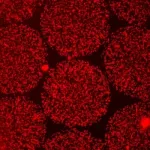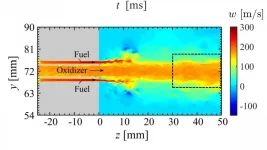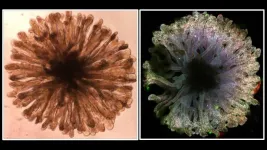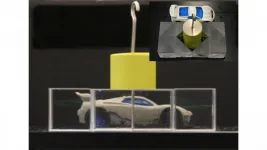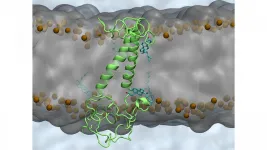(Press-News.org) Researchers at the University of Maryland School of Medicine (UMSOM) have developed two rapid diagnostic tests for COVID-19 that are nearly as accurate as the gold-standard test currently used in laboratories. Unlike the gold standard test, which extracts RNA and uses it to amplify the DNA of the virus, these new tests can detect the presence of the virus in as little as five minutes using different methods.
One test is a COVID-19 molecular diagnostic test, called Antisense, that uses electrochemical sensing to detect the presence of the virus. The other uses a simple assay of gold nanoparticles to detect a color change when the virus is present. Both tests were developed by Dipanjan Pan, PhD, Professor of Diagnostic Radiology and Nuclear Medicine and Pediatrics at UMSOM and his research team. Dr. Pan has a joint appointment at the University of Maryland Baltimore County (UMBC).
"These tests detect the presence of the virus within 5 to 10 minutes and rely on simple processes that can be performed with little lab training," said Dr. Pan. They do not require the extraction of the virus's RNA - which is both complicated and time consuming.
They also are more reliable than the rapid antigen tests currently on the market, which detect the virus only in those with significantly high viral levels. "These two newer tests are extremely sensitive and can detect the presence of the virus, even in those with low levels of the virus," Dr. Pan said.
Dr. Pan's team included UMSOM research fellow Maha Alafeef, UMSOM research associate Parikshit Moitra, PhD, and research fellow Ketan Dighe, from UMBC.
Last month, the U.S. Food and Drug Administration (FDA) registered the laboratory of Dr. Pan as an approved laboratory development site for the Antisense test. The move paves the way for Dr. Pan's laboratory to begin conducting the test at the university, in research settings, as it undergoes further development.
In February, RNA Disease Diagnostics, Inc. (RNADD) received an exclusive global license from UMB and UMBC to commercialize the test. Dr. Pan serves as an unpaid scientific advisor to the company.
This test detects the virus in a swab sample using an innovative technology called electrochemical sensing. It uses a unique dual-pronged molecular detection approach that integrates electrochemical sensing to rapidly detect the SARS-CoV-2 virus.
"The final prototype is like a glucometer, which patients with diabetes use at home to measure their blood glucose levels," said Dr. Pan, "and is just as easy for people to do themselves."
Dr. Pan and his colleagues, in collaboration with RNA Disease Diagnostics, are launching a study of NBA basketball players in New York City to compare the Antisense test to rapid COVID tests that the NBA is using to monitor COVID infections in its players.
"We would like to see whether our test can yield more reliable results compared to the existing platforms," he said. "Current antigen-based rapid COVID tests miss infections about 20 percent of the time and also have high rates of false positive results. Our Antisense test appears to be about 98 percent reliable, which is similar to the PCR test."
Similar to the Antisense test, the second rapid test also does not require the use of any advanced laboratory techniques, such as those commonly used to extract RNA, for analysis. It uses a simple assay containing plasmonic gold nanoparticles to detect a color change when the virus is present. In April, Dr. Pan and his colleagues published a stepwise protocol in the journal Nature Protocols, explaining how the nano-amplified colorimetric test works and how it can be used.
Once a nasal swab or saliva sample is obtained from a patient, the nucleic acid (bits of genetic material) in the sample is amplified via a simple process that takes about 10 minutes. The test uses a highly specific molecule attached to the gold nanoparticles to detect a particular protein. This protein is part of the genetic sequence that is unique to the novel coronavirus. When the biosensor binds to the virus's gene sequence, the gold nanoparticles respond by turning the liquid reagent from purple to blue.
"Innovations in COVID-19 testing remain incredibly important even as the epidemic appears to be waning in this country," said E. Albert Reece, MD, PhD, MBA, Executive Vice President for Medical Affairs, UM Baltimore, and the John Z. and Akiko K. Bowers Distinguished Professor and Dean, University of Maryland School of Medicine. "As we continue to monitor infections in unvaccinated segments of our population and the potential spread of new variants, there will be a vital need for inexpensive rapid tests to ensure that we continue to maintain low infection rates."
INFORMATION:
About the University of Maryland School of Medicine
Now in its third century, the University of Maryland School of Medicine was chartered in 1807 as the first public medical school in the United States. It continues today as one of the fastest growing, top-tier biomedical research enterprises in the world -- with 45 academic departments, centers, institutes, and programs; and a faculty of more than 3,000 physicians, scientists, and allied health professionals, including members of the National Academy of Medicine and the National Academy of Sciences, and a distinguished two-time winner of the Albert E. Lasker Award in Medical Research. With an operating budget of more than $1.2 billion, the School of Medicine works closely in partnership with the University of Maryland Medical Center and Medical System to provide research-intensive, academic and clinically based care for nearly 2 million patients each year. The School of Medicine has more than $563 million in extramural funding, with most of its academic departments highly ranked among all medical schools in the nation in research funding. As one of the seven professional schools that make up the University of Maryland, Baltimore campus, the School of Medicine has a total population of nearly 9,000 faculty and staff, including 2,500 student trainees, residents, and fellows. The combined School of Medicine and Medical System ("University of Maryland Medicine") has an annual budget of nearly $6 billion and an economic impact more than $15 billion on the state and local community. The School of Medicine, which ranks as the 8th highest among public medical schools in research productivity, is an innovator in translational medicine, with 600 active patents and 24 start-up companies. The School of Medicine works locally, nationally, and globally, with research and treatment facilities in 36 countries around the world. Visit medschool.umaryland.edu
Two new studies have cast unprecedented light on disease processes in tuberculosis, identifying key genetic changes that cause damage in the lungs and a drug treatment that could speed up recovery.
Tuberculosis (TB) is a lung infection that has killed more humans than any other and until last year was the top infectious killer around the world. Globally, an estimated 10 million people develop the disease each year.
The findings are reported in two papers in the Journal of Clinical Investigation.
In the first study, a team from the University of Southampton used a new 3D culture system they have developed to observe the changes that occur in cells infected with TB. Unlike the laboratory-standard 2D culture system, where cells are placed ...
This past year has been transformational in terms of not only a global pandemic but a sustained focus on racism and systemic injustice. There has been a widespread circulation of images and videos in the news and online. Just like adults, adolescents are exposed to these images with important consequences for their emotional health and coping. However, few studies have sought to understand the influence of racism experienced online.
According to a qualitative study published in JAMA Network Open adolescents expressed feelings of helplessness when exposed to secondhand racism online. Specifically, adolescents described helplessness stemming from the pervasiveness of racism in our society. This was illustrated by quotes, such as "[racist events are] just another day in the life" referring ...
WASHINGTON, June 8, 2021 -- Combustion engines can develop high frequency oscillations, leading to structural damage to the engines and unsafe operating conditions. A detailed understanding of the physical mechanism that causes these oscillations is required but has been lacking until now.
In Physics of Fluids, by AIP Publishing, research from the Tokyo University of Science and the Japan Aerospace Exploration Agency clarifies the feedback processes that give rise to these oscillations in rocket engines.
The investigators studied simulated combustion events in a computational model of a rocket combustor. Their analysis involved sophisticated techniques, including symbolic ...
For many, the Thale cress (Arabidopsis thaliana) is little more than a roadside weed, but this plant has a long history with scientists trying to understand how plants grow and develop. Arabidopsis was first scientifically described as early as the 16th century and the first genetic mutant was identified in the 1800s. Since the 1940s, Arabidopsis has increased in popularity within the scientific community, which continues to use it as a model system to explore plant genetics, development and physiology to this day.
One might expect that after decades of scientific scrutiny the structure of Arabidopsis had been fully documented, but a new study from scientists from The Pennsylvania State University, USA, has revealed that this humble plant still has some surprises. The researchers describe ...
A team of scientists at the Keck School of Medicine of USC has created what could be a key building block for assembling a synthetic kidney. In a new study in Nature Communications, Zhongwei Li and his colleagues describe how they can generate rudimentary kidney structures, known as organoids, that resemble the collecting duct system that helps maintain the body's fluid and pH balance by concentrating and transporting urine.
"Our progress in creating new types of kidney organoids provides powerful tools for not only understanding development and disease, but also finding new treatments and regenerative approaches for patients," said Li, the study's corresponding ...
What The Study Did: In this survey of 1,186 medical, graduate and health professional school faculty, more faculty considered leaving since the COVID-19 pandemic than before. Faculty with children, particularly female faculty with children, were more likely to consider leaving since the pandemic.
Authors: Susan A. Matulevicius, M.D., M.S.C.S., of the University of Texas Southwestern in Dallas, is the corresponding author.
To access the embargoed study: Visit our For The Media website at this link https://media.jamanetwork.com/
(doi:10.1001/jamanetworkopen.2021.13539)
Editor's Note: Please ...
What The Study Did: Researchers examined whether a sweetened beverage tax in Philadelphia was associated with sustained changes in beverage prices and purchases of sweetened beverages and high-sugar foods two years after implementation of the tax.
Authors: Christina A. Roberto, Ph.D., of the University of Pennsylvania Perelman School of Medicine in Philadelphia, is the corresponding author.
To access the embargoed study: Visit our For The Media website at this link https://media.jamanetwork.com/
(doi:10.1001/jamanetworkopen.2021.13527)
Editor's Note: The article includes conflicts of interest ...
What The Study Did: Focus groups were conducted with teenagers to examine their responses to exposure to online and media-based vicarious racism and to explore coping strategies that may be used to combat negative emotions.
Authors: Nia Heard-Garris, M.D., M.Sc., of Ann and Robert H. Lurie Children's Hospital of Chicago, is the corresponding author.
To access the embargoed study: Visit our For The Media website at this link https://media.jamanetwork.com/
(doi:10.1001/jamanetworkopen.2021.13522)
Editor's Note: The article includes conflicts of interest and funding/support disclosures. Please ...
WASHINGTON, June 15, 2021 -- Optical cloaking allows objects to be hidden in plain sight or to become invisible by guiding light around anything placed inside the cloak. While cloaking has been popularized in fiction, like in the "Harry Potter" books, researchers in recent years have started realizing cloaks that shield objects from view by controlling the flow of electromagnetic radiation around them.
In the Journal of Applied Physics, by AIP Publishing, researchers from the Toyota Research Institute of North America examined recent progress of developing invisibility ...
WASHINGTON, June 15, 2021 -- Alzheimer's disease is predominant in elderly people, but the way age-related changes to lipid composition affect the regulation of biological processes is still not well understood. Links between lipid imbalance and disease have been established, in which lipid changes increase the formation of amyloid plaques, a hallmark of Alzheimer's disease.
This imbalance inspired researchers from Aarhus University in Denmark to explore the role of lipids comprising the cellular membranes of brain cells.
In Biointerphases, by AIP Publishing, the researchers report on the significant role lipids may play in regulating C99, a protein within the amyloid pathway, and disease progression. Lipids have been mostly overlooked from a therapeutic standpoint, likely because ...
